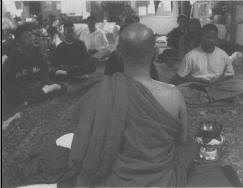Buddhism, introduced to China around 67AD by two monks coming from India,
has a history of a long process of importation, assimilation and
transformation of a foreign religion which progressively became one of
the main foundations of the Chinese society as well as a powerful
artistic inspiration. The religion was then exported to western
countries more than a century ago and the last 35 years have witnessed
an explosion of interest in a Buddhism which, however, presents
different characteristics from its Asian ancestor.
公元67年前后两名天竺僧人将佛教带到中国。在此后的1000多年里佛教对中国的政治、经济、文化产生了重大影响同时佛教自身也受到中国文化的深远影响。
大约一个世纪以前佛教传入了西方社会。在过去的35年里佛教在西方有了快速的发展,并在那里形成了新的鲜明特色。
The Venerable Khon Sao, a Buddhist monk, teaches youths how to pray at a Buddhist temple on October 23, 2003 in Massachusetts in the United States.
2003年10月23日在美国马萨诸塞州罗维尔市,一名僧人向几个少年传授佛教教义。

The Origin of Buddhism
佛教的起源
Tradition
teaches that the historical Buddha was born around 563 BC into an
eminent family of the Sakya clan located among the foothills of the
Himalayas between present-day Nepal and India. His personal name was Siddhartha, but he later became known as Sakyamuni (Sage of the Sakyas).
At the age of
29 he rejected the life of luxury in which he had been raised, and left
his home and family to seek understanding of the suffering and
mortality inherent in all life. After years of searching, at the age of
35, he found spiritual enlightenment during a night of meditation.
Thereafter, he devoted the rest of his life to teaching the insights he
had attained.
Buddha
believed that there was a continuous cycle of death and rebirth and that
each person's position and well-being in life was determined by his/her
behavior in previous lives. A person's good deeds and acts might lead
to a rebirth as a wise and wealthy person or as a heavenly being . A
person's bad deeds and evil acts might lead to a rebirth as a poor and
sickly person.
Buddha
also believed that the experiences of pain and suffering are a part of a
person's life, and he taught that the only way to escape human
suffering was to give up worldly desires such as power, wealth, and
beauty. Thus, one could gain perfect peace and happiness and, after
death, the transcendent state known as nirvana.
The History and Development of Buddhism in China
佛教在中国
Buddhism was introduced to China about 67 AD by two Indian monks, Moton and Chufarlan, who had been invited by Emperor Ming of the Han Dynasty to establish the Temple of White Horse in the Capital Luoyang in Henan Province.
Buddhism has profoundly affected Chinese culture, politics, literature and philosophy, but China has also had a great effect upon Buddhism: Chinese Buddhism being a distinct entity from its Indian roots.
However, in the beginning Buddhism did not have much influence in China
due to the prevailing traditional Chinese philosophy of Confucius. With
the downfall of the Han Dynasty in 220 AD and the troubled chaotic
period that followed, Buddhism was able to spread to different regions
of China.
China was divided into two regions. The northern region of China
was governed by nomad rulers who did not practice traditional Confucian
beliefs and encouraged Buddhist practices. The southern region of China
was governed by Han Chinese rulers who were dissatisfied with
traditional Confucian beliefs and began to take an interest in Buddhist
thought.
Quickly,
Buddhism was accepted by the common people as well as by government
officials and rulers and by the late 4th century, 90 percent of the
people in the northwest region of China (closest to central Asia and the Silk Road) were Buddhists. From China, Buddhism spread to Japan and Korea.
The popularization of Buddhism during the period is evident in
the many scripture filled caves and structures surviving today. The Mogao Caves near Dunhuang in Gansu Province, the Longmen Grottoes near Luoyang in Henan Province and the Yungang Grottoes near Datong in Shanxi Province
are the most renowned of the northern region. The Leshan Giant Buddha
carved out of a hillside in the 8th century during Tang Dynasty and
looking down on the confluence of three rivers, is still the largest
Buddha statue in the world.
The Various Branches of Buddhism in China
中国佛教的宗派
Based on different languages, sections and nationalities. Buddhism in China is divided into Han Buddhism, Tibetan Buddhism and Theravada.
Tibetan Buddhism is the predominant religion for Tibetans, Mongolians and the Yugu people in Tibet, Gansu, Qinghai of China. Theravada is popular with some minor nationalities in South West China's Yunnan Province.
When Buddhism moved to China
it met a religiously sophisticated culture and, as a result, a number
of Chinese-indigenous schools of Han Buddhism developed, such as Chan,
Huayan, Pure Land and Tiantai.